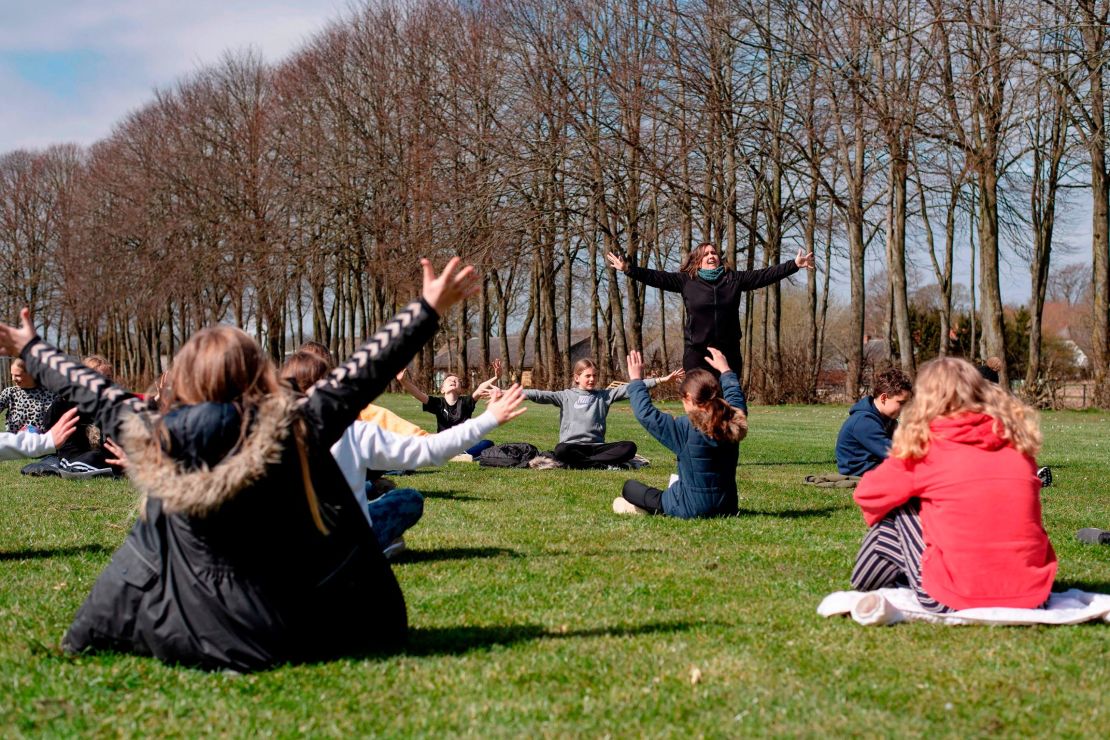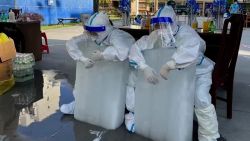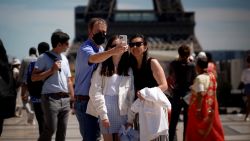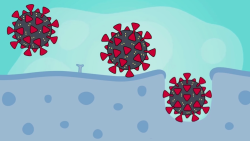A version of this story appeared in the July 9 edition of CNN’s Coronavirus: Fact vs. Fiction newsletter. Sign up here to receive the need-to-know headlines every weekday.
Hours after President Donald Trump berated the US Centers for Disease Control and Prevention over its guidelines for safely reopening schools, slamming them as “very tough” and “expensive,” the agency said Wednesday it would issue new recommendations next week.
A day later, the CDC clarified that existing guidelines would not be revised, but additional reference documents would be provided.
The move came as the Trump administration makes a concerted push for schools to reopen by the fall, even as cases surge in the US South and West, and record numbers of new infections are clocked daily.
Dr. Robert Redfield, the CDC director, said Wednesday that his recommendations — which include reconfiguring classrooms to allow for social distancing and updating ventilation systems — shouldn’t be used as an excuse to keep schools closed. It was among the most direct comments he’s made on the matter, as educators across the country try to divine meaning from conflicting messaging and weigh the risks of welcoming students back.
Trump has pointed to Germany and some of the Nordic nations as places where “schools are reopening with no problems.” But America’s handling of the pandemic is incomparable to most of those countries, where the coronavirus curve was successfully flattened before schools went back into session.
Denmark was one of the first European countries to reopen schools back in April, but it was also one of the first to lock down its society. Among the safety measures in place for students: Smaller class sizes, mandatory hand-washing, regular sanitizing, staying outdoors as much as possible and social distancing.
In sharp contrast to Denmark, the issue of reopening schools has become politicized in the US – not unlike masks. “We really spent time putting together the science behind this and we believe it’s the right call. But now because the President has made it into a political issue, it likely won’t happen,” one senior CDC official told CNN, referring to the enforcement of existing guidelines.
Meanwhile, teachers, parents and pupils caught in the middle of this tug-of-war are worried about safety. Despite the challenges of remote learning, and suggestions from the American Academy of Pediatrics that keeping kids out of class is doing more harm than good, the lack of clarity is nerve-wracking.
“It scares me to send him back to school not knowing if other people are taking precautions, or trying to educate their children about keeping their masks on,” Jaime Nalls, a mother of four in Albuquerque, New Mexico, said of her 9-year-old son, who has asthma.

YOU ASKED. WE ANSWERED
Q: What is a positivity rate and how is it calculated?
A: You may have noticed health officials and politicians using the term “positivity rate.” It’s the percentage of people who tested positive for Covid-19 out of all the people who were tested.
So, as more and more people are being tested, the focus is shifting to the positivity rate – how many of those tested are actually infected.
A lot of officials, such as Miami-Dade County Mayor Carlos Gimenez, point to a rising positivity rate to counter arguments that the increase in case numbers is simply the result of more people being tested. The positivity rate “is the real issue,” Gimenez told CNN’s Wolf Blitzer on Monday.
Send your questions here. Are you a health care worker fighting Covid-19? Message us on WhatsApp about the challenges you’re facing: +1 347-322-0415.
WHAT’S IMPORTANT TODAY
What secondary lockdowns mean for the future of fighting Covid-19
After months of closures, governments are eager to reopen schools and businesses to allow people to get on with their lives. But fresh clusters of infections, blamed on a mix of relaxed guidelines and complacency, have seen leaders forced to reimpose restrictions in some hotspots – even as rules are eased elsewhere in the same country.
The threshold for imposing new lockdowns, as well as their size and scope, varies dramatically between countries – from a single building in Italy, to several Rwandan villages, to a community of 200,000 in Spain’s northeast and a coastal area of 70,000 in its northwest. The countries and territories that seemed most on top of the coronavirus are now seeing second and third waves, pointing again to the immense difficulty of containing the pandemic even with partial border closures and quarantines in place.
Below we take a look at how various countries are coping, and what their responses might mean for how we handle Covid-19 in future.
Australia adopts China’s approach
This week, Australia’s second largest city, Melbourne, went back into lockdown, as the country closed the boundary between the states of Victoria and New South Wales for the first time in 100 years.
Melbourne residents are no longer allowed to leave their homes unless it’s for grocery shopping, caregiving, exercise or work. Cafes and restaurants that were allowed to reopen weeks ago have again suspended regular services, and are now offering delivery and take-out options only. All beauty services and entertainment venues are also closed.
It’s not dissimilar from the response seen in China, which managed to get its own epidemic largely under control months ago, and has responded to recent infection spots with rapid, albeit sometimes draconian, action. If these sorts of sweeping restrictions are the answer to the ongoing Covid-19 dilemma, it begs the question of how a country like the US – where even basic precautions, like masks, are divisive – can quash fresh outbreaks.
Hong Kong is battling a third wave. Yes, you read that right.
Authorities in Hong Kong, a city lauded for its quick and effective response to the coronavirus pandemic, are now warning of potential “exponential growth” in new cases of Covid-19 after a surge in local transmissions, which officials have been unable to contact trace. They’re calling it a “third wave.”
The city’s success in containing Covid-19 has been attributed to the government’s vigilant enforcement of quarantine for overseas arrivals, efficient contact tracing and residents’ willingness to practice good hygiene, wear masks and practice social distancing – efforts which are still ongoing. The upswing demonstrates just how difficult it is to control the coronavirus – even at the best of times, completely eliminating the risk may be impossible.
The government is now seriously considering bringing back measures that were lifted in late June as cases eased, like limiting the amount of people allowed to gather in public, shutting bars and requiring restaurants to further slash capacity.
US health officials call for more stringent restrictions
As the US crosses 3 million cases, setting new daily records for infections, Trump is now in open dispute with his own health officials, raising questions about how a divided government can move efficiently to get the virus under control.
At least two dozen US states have paused or rolled back reopening plans as cases surge, while spikes in 35 states are threatening to reverse the progress made during weeks of stressful shutdowns. The US must control crowds, get people wearing masks and do a better job on physical distancing to get on top of the surging pandemic, Dr. Anthony Fauci, the nation’s leading infectious disease expert, said Wednesday. “We’ve got to get our arms around this,” Fauci told the Wall Street Journal. “We’ve got to be stringent.”
ON OUR RADAR
- As the pandemic widens in the US, Canadians and Mexicans agree: Keep the border closed.
- The Chinese Foreign Ministry has accused US Secretary of State Mike Pompeo of “making up all sorts of fake news” to smear China and damage the country’s international relations.
- The Ivy League, which includes colleges like Harvard, Princeton and Yale, has canceled football, and all other fall sports, due to Covid-19 fears. Meanwhile, Stanford has cut 11 varsity sports programs as the pandemic worsens finances.
- The US FDA has warned of more hand sanitizer products with potentially dangerous methanol contamination.
- As Brazil’s cases surge, the country is contending with a parallel outbreak – a flurry of corruption investigations into the alleged misuse of public money rapidly shelled out for Covid-19 emergency procurement.
- Furious crowds have rioted in the Serbian capital Belgrade for a second day in a row, breaking into parliament, in protest over President Aleksandar Vucic’s handling of the coronavirus crisis.
- No, it’s not just for extra leg room. Portuguese charter operator Hi Fly has removed most of the seats from its sole A380 — the world’s first to be converted for freight — to transport medical and protective equipment for Covid-19.
TOP TIPS
It could be impossible to operate schools safely in communities where coronavirus infections are out of control, Dr. Tom Frieden, former director of the CDC, said on Wednesday. But, he added, when the time comes to reopen, schools should be taking these eight steps:
- Shield the most vulnerable
- Reduce risk wherever possible, which may mean re-engineering the school environment
- Keep the virus out by restricting access and requiring visitors to wear face masks and wash their hands
- Reduce occupancy, which may include a split shift or a week-on/week-off schedule
- Reduce mixing by dividing students into smaller groups
- Have teachers and students wear masks all day long
- Implement new health and safety protocols, including more frequent cleaning
- Have protocols in place for when Covid-19 cases develop
TODAY’S PODCAST
“Our best hope for now is that our leaders take after the immune system and adapt to the new threats that this virus presents.” – Erin Bromage, immunologist
CNN contributor Erin Bromage has committed his life’s work to studying the immune system. He says scientists have a long way to go before understanding how Covid-19 affects our bodies. Check out today’s podcast for an immune system crash course. Listen Now.

















